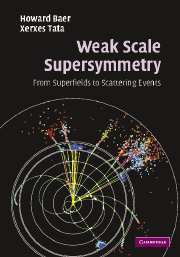Book contents
- Frontmatter
- Contents
- Preface
- 1 The Standard Model
- 2 What lies beyond the Standard Model?
- 3 The Wess–Zumino model
- 4 The supersymmetry algebra
- 5 Superfield formalism
- 6 Supersymmetric gauge theories
- 7 Supersymmetry breaking
- 8 The Minimal Supersymmetric Standard Model
- 9 Implications of the MSSM
- 10 Local supersymmetry
- 11 Realistic supersymmetric models
- 12 Sparticle production at colliders
- 13 Sparticle decays
- 14 Supersymmetric event generation
- 15 The search for supersymmetry at colliders
- 16 R-parity violation
- 17 Epilogue
- Appendix A Sparticle production cross sections
- Appendix B Sparticle decay widths
- Appendix C Higgs boson decay widths
- Bibliography
- Index
15 - The search for supersymmetry at colliders
- Frontmatter
- Contents
- Preface
- 1 The Standard Model
- 2 What lies beyond the Standard Model?
- 3 The Wess–Zumino model
- 4 The supersymmetry algebra
- 5 Superfield formalism
- 6 Supersymmetric gauge theories
- 7 Supersymmetry breaking
- 8 The Minimal Supersymmetric Standard Model
- 9 Implications of the MSSM
- 10 Local supersymmetry
- 11 Realistic supersymmetric models
- 12 Sparticle production at colliders
- 13 Sparticle decays
- 14 Supersymmetric event generation
- 15 The search for supersymmetry at colliders
- 16 R-parity violation
- 17 Epilogue
- Appendix A Sparticle production cross sections
- Appendix B Sparticle decay widths
- Appendix C Higgs boson decay widths
- Bibliography
- Index
Summary
While the first clear hints of deviation from the SM may well come from any of a large variety of experiments, establishing precisely what the new physics is will be possible only by observations at energy scales close to, or beyond, the threshold for the new phenomena. Direct examination of the properties of any new states of matter associated with the new physics is probably the best way to study the new phenomena, if these degrees of freedom are kinematically accessible. If the new physics is supersymmetry, then the new states of matter will be the superpartners, and it is only by determining their quantum numbers and couplings that we can unambiguously establish that the new physics is actually supersymmetry. Of course, any new states of matter may be quite different from superpartners. For instance, if extra spatial dimensions exist which are accessible at the weak scale, the new degrees of freedom will be Kaluza–Klein excitations of SM particles. It is even possible that no new degrees of freedom are directly accessible, but that SM interactions acquire form factors that point to what the new physics might be. Our point here is that elucidation of new physics will only be possible at colliding beam facilities.
The purpose of this chapter is to examine what may be learned from a study of high energy collisions assuming that nature is supersymmetric at the weak scale. To start with, we review various searches for supersymmetry in previous collider and fixed target experiments.
- Type
- Chapter
- Information
- Weak Scale SupersymmetryFrom Superfields to Scattering Events, pp. 394 - 453Publisher: Cambridge University PressPrint publication year: 2006

